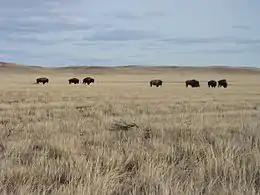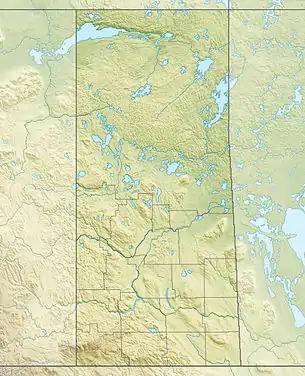Grasslands National Park
Grasslands National Park is a Canadian national park located near the village of Val Marie, Saskatchewan, and one of 44 national parks and park reserves in Canada's national park system (though one of only two in Saskatchewan itself). This national park is north from the American state of Montana and lies adjacent to the international boundary.
| Grasslands National Park | |
|---|---|
IUCN category II (national park) | |
 Bison grazing in Grasslands National Park | |
 Location of Grasslands National Park in Canada  Location of Grasslands National Park in Saskatchewan | |
| Location | Saskatchewan, Canada |
| Nearest city | Val Marie 49°12'03.9"N+107°42'37.8 |
| Coordinates | 49°12′03.85″N 107°42.′37.8″W |
| Area | 907 km2 (350 sq mi) |
| Established | 1981 |
| Visitors | 11,597[1] (in 2015-16) |
| Governing body | Parks Canada |
| Grasslands National Park | |
The park was established in 1981. Prior to this the province's only national park was Prince Albert National Park.
Grasslands National Park represents the Prairie Grasslands natural region, protecting one of the nation's few remaining areas of undisturbed dry mixed-grass/shortgrass prairie grassland. The park is located in the World Wildlife Fund-defined Northern short grasslands ecoregion, which spans much of southern Saskatchewan, southern Alberta, and the northern Great Plains states in the USA. The unique landscape and harsh, semi-arid climate provide niches for several adapted plants and animals. The park and surrounding area house the country's only black-tailed prairie dog colonies. Fauna found in the park include bison, pronghorns, greater sage-grouses, burrowing owls, coyotes, ferruginous hawks, swift foxes, prairie rattlesnakes, black-footed ferrets and greater short-horned lizards.[2] Flora includes blue grama grass, needlegrass, plains cottonwood and silver sagebrush.[3]
Erosion by glacial meltwater formed many of the park's characteristic features. Highlights of the park's geological landscape include the Frenchman River Valley, the Seventy Mile Butte, and the badlands of Rock Creek.
In 1874, Sir George Mercer Dawson discovered western Canada's first dinosaur remains in the Killdeer Badlands during the International Boundary Survey. Later, in 1877, Sitting Bull took refuge in the area with around 5000 Sioux after the defeat of General Custer at the Battle of Little Bighorn.[4]
Visiting

The West Block of the park is located one hour south of Swift Current, and the main visitor reception centre is located in the town of Val Marie. Highlights of the West Block include the Frenchman River Valley, a herd of over 300 Plains bison as well as prairie dog colonies. A new campground called the Frenchman Valley Campground offers visitors serviced camping sites, teepee camping and a cook shelter. Backcountry camping is also available. The West Block is located in Division No. 4, Saskatchewan.
The East Block of the park is about an hour's drive south of Assiniboia near Wood Mountain Regional Park. The interpretive centre is in the McGowan House at the new Rock Creek Campground. The East Block is more of a wilderness area but has views of the badlands of Rock Creek, the Cretaceous–Paleogene boundary and prairie skies. The East Block is located in Division No. 3, Saskatchewan.
In 2006, Plains bison from Elk Island National Park in Alberta were reintroduced to Grasslands.[5] By 2015 the herd had grown from the original 71 animals to over 300.[6] The herd is maintained on a 181 km2 section in the park's West Block. On October 2, 2009, in a ceremony at Belza House, the park was declared a dark-sky preserve,[7] and a small population of black-footed ferrets was reintroduced into the prairie dog towns after a 70-year absence. Improved night-lighting practices under the dark-sky agreement ensure that the park remains dark at night, preserving a natural environment for all nocturnal wildlife.[8]
The park annually receives about 12,000 visitors. Its official name in French is Parc national des Prairies.
See also
- The Grasslands Project: a 2016 series of 10 short documentary films about small rural communities
- National Parks of Canada
- List of National Parks of Canada
- List of Saskatchewan parks
- List of protected grasslands of North America
References
- Parks Canada Visitation Records Accessed November 17, 2016
- "Ferrets, foxes and the fringed orchid: Species that suffer when grasslands are threatened". The Nature of Things: Science, Wildlife and Technology. CBC. Retrieved 2020-10-12.
- Camping in Grasslands National Park, Parks Canada
- Grasslands National Park of Canada: Human - Land Relationships - Human History, Parks Canada, archived from the original on February 10, 2013, retrieved April 13, 2012
- Where buffalo roam, Montreal Gazette, July 23, 2007, archived from the original on April 11, 2014, retrieved April 13, 2012
- Bison update, Parks Canada, Nov 10, 2017, retrieved Nov 14, 2017
- "Parks Canada". World Class Astronomy. January 29, 2016. Retrieved October 2, 2016.
- Grasslands National Park, Parks Canada, retrieved April 13, 2012
External links
| Wikimedia Commons has media related to Grasslands National Park. |
- The Prairie Learning Centre
- "Northern Short Grasslands". Terrestrial Ecoregions. World Wildlife Fund.
- Grasslands National Park - Encyclopedia of Saskatchewan